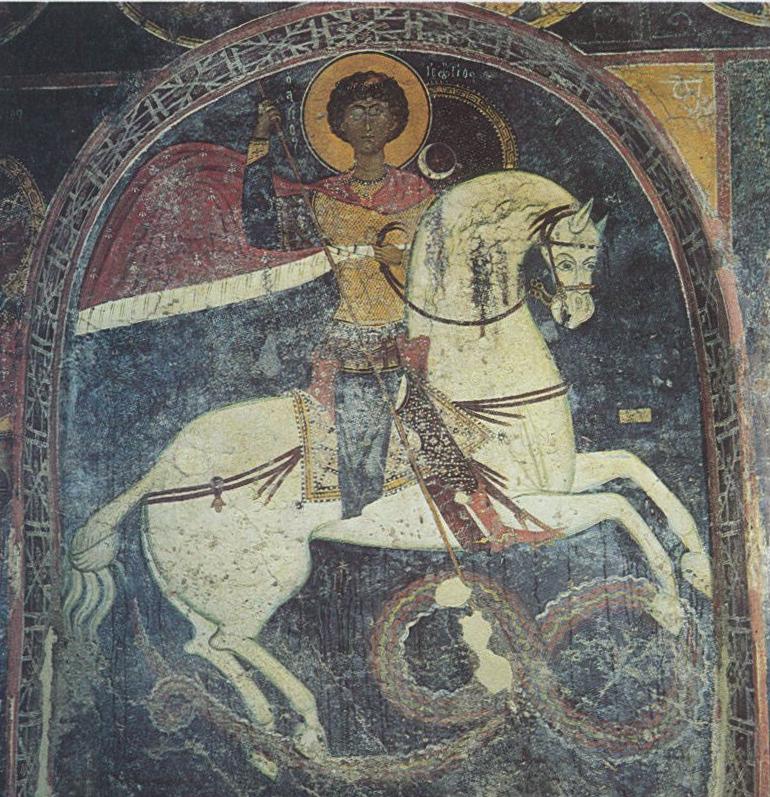
Try Amazon Audible Plus
Saint George, Mounted, Byzantine Mural, Saint John Chrysostom Church, Geraki, Greece, c.1300AD.
Byzantine Morea

A larger detail of Saint George, Byzantine Mural, Saint John Chrysostom Church, Geraki (Geronthres), Greece


Source: Image 11, page 226 PDF 4 - "Geraki" in Monuments of Byzantine Settlements - Studies on the Monumental Remnants of Mediaeval Greece by N.C. Moutsopoulos & G. Dimitrokallis (in Greek)
Black and white image referred to in the text: Image 65, page 40 PDF 1 - "Geraki" in Monuments of Byzantine Settlements - Studies on the Monumental Remnants of Mediaeval Greece by N.C. Moutsopoulos & G. Dimitrokallis
Series Director: Prof. N.C. Moutsopoulos, Editor in Chief: Prof. I.E. Karayannopoulos.
Note the crescent and 8 pointed star on his shield, which is displayed behind him.
Referenced as Fig. 9 in "Art and Identity in the Medieval Morea" by Sharon E. J. Gerstel in The Crusades from the Perspective of Byzantium and the Muslim World edited by Angeliki E. Laiou and Roy Parviz Mottahedeh. Dumbarton Oaks Research Library and Collection, Washington, D.C., 2001
p271:
In village churches of the Byzantine Morea, the equestrian saint, whose horse easily occupies the space of three standing figures within the painted program, often dominates the lower register of the interior decoration. The newly invested importance of the equestrian saint is seen in the church of St. John Chrysostom in Geraki. In this small, single-aisled church of roughly 1300, the portrait of St. George on horseback is placed directly opposite the entrance to the building (Fig. 9).48 Although he is mounted to do battle with the serpent coiled below the hooves of his horse, the upper part of his torso and his face are turned to confront the viewer directly. The first impression of the church interior is thus formed by an encounter with the votive portrait of the holy rider.
pp.278-279
The last detail that remains for discussion is the use of heraldic symbols to express the political and religious allegiance of the saint. Such markings must have become increasingly necessary as Latins and Greeks pressed claims on the same corps of saints. At Nauplion, the portrait of St. George was painted by a local, Orthodox artist, who identified the saint as a Latin by painting a specific badge on his shield, a red cross on a white ground (Fig. 3). A number of Orthodox saints in the Morea carry shields marked by insignia, perhaps in imitation of the Latin custom. In the West, the knights’ seals regularly incorporated such heraldic devices to establish identity.89
6 Seal of Florent de Hainault, Latin Prince of Achaia, Morea, Greece (photo: after G. Schlumberger, F. Chalandon, and A. Blanchet, Sigillographie de l'Orient latin, [Paris. 1943], pl. IX.2)
As Florent of Hainault’s shield demonstrates, the Latin rulers of the Morea followed this practice (Fig. 6). The typical badge of the Orthodox saint in this region is formed of a crescent moon and star. The motif appears in several churches in Geraki and in two churches in nearby Epidauros Limera.90 The earliest church in the Morea to include a saint holding a shield marked by the crescent and star may be St. John Chrysostom, which has been dated on the basis of style to ca. 1300, some forty years following the return of Geraki to Byzantium (Fig. 9). The north wall of the church presents a unique juxtaposition of two shields in superimposed scenes that are opposite the entrance. In the vault above the portrait of St. George, the scene of the Women at the Tomb forms part of the narrative cycle.91 In the lower right corner of the scene is a group of sleeping soldiers (Fig. 15). The shield of one of the soldiers is decorated with a small castle, a well-known symbol in the region. The reverse sides of contemporaneous Frankish coins minted in the Morea feature the castle tournois, a schematic rendering of a Latin castle consisting of a central turret flanked by two smaller towers.92 Through the use of this motif, the Roman soldiers are associated with Latins; the coat of arms that marks the shield is identified with the Frankish denier tournois, the local replacement of the debased Byzantine currency. The shield of the equestrian St. George is also marked with a badge, though comprised of a crescent and star. Two sets of scholars have attempted to trace the origins of this motif on the shields of Orthodox military saints, and a convincing argument has been made for its association with coins minted in Constantinople, especially an anonymous bronze follis of Alexios I Komnenos (1081–1118).93This coin, decorated with a cross on crescent, has been found in large numbers in excavations at Corinth and Athens.94 The use of the motif for the painted shield of military saints in churches of the Morea may evoke the memory of the last powerful Byzantine dynasty to reign before Villehardouin came ashore at Methone. The Geraki painter juxtaposed motifs borrowed from Byzantine and Frankish coinage in order to identify Orthodox and Latin warriors. In a period in which numismatic imagery carried powerful associations, it is significant that coin motifs were used as signifiers of political allegiance.
A cross, crescent and stars on a coin of Emperor Alexios I Komnenos. SB 1900 Alexius I, 1081-1118AD